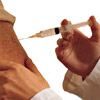Early immune activation could lead to better vaccines
Researchers at Albert Einstein College of Medicine of Yeshiva University have discovered a new “first response” mechanism that the immune system uses to respond to infection. The findings challenge the current understanding of immunity and could lead to new strategies for boosting effectiveness of all vaccines. The study, conducted in mice, published online in the journal Immunity.
One way the immune system protects the body against microbes like bacteria and viruses is with memory CD8+ T cells, so named because they can “remember” the invading organisms. If someone is later infected by that same microbe, memory CD8+T cells recognise the invaders and multiply rapidly, forming an army of cytotoxic T cells to hunt down and destroy the microbes and the cells they’ve infected. This highly specific immune response forms the basis for most vaccines—but it can take several weeks for them to prime the immune system to respond to “real” infections.This new study shows that the immune system has another, faster method for responding to infections that could be exploited to produce faster-acting vaccines.
“Our research has revealed that pathogen-specific memory CD8+ T cells are reactivated even before they recognise the antigen they previously encountered,” said study leader Grégoire Lauvau, Ph.D., associate professor of microbiology and immunology at Einstein. (Antigens are protein fragments of microbes that trigger an immune response.)
Dr. Lauvau and his colleagues found that this fast-acting immune response is orchestrated by a type of white cell called inflammatory monocytes. After the immune system detects an infection, it recruits monocytes to the affected tissues, where they release inflammatory signals called cytokines. Those inflammatory signals not only activate every memory CD8+ T cell that has previously encountered a pathogen but also stimulate the activation of natural killer cells, another type of white blood cell.
The result is a protective immunologic environment capable of defending against microbes of any kind—viruses, bacteria or parasites. Only later do memory CD8+ T cells specific for that microbe’s antigen begin to multiply, enabling the immune system to launch its focused attack on that particular microbe.
“We’re not saying that recognising the antigen is unimportant in the immune response,” says Dr. Lauvau. “You do need the antigen later on, to cause memory CD8+ T cells to multiply and to get full pathogen-specific protection. But it doesn’t seem to be needed during the days immediately following re-infection, when this early form of immunity is operating.”
“It’s too early to apply these findings clinically,” said Dr. Lauvau. “For example, we still need to identify all of the cells and signaling molecules that are involved, and learn how and when the immune system switches from the first phase of protection to the second phase, where you have the antigen. But the important concept to take from this study is that it may be possible to improve vaccines by making this early, generalised immune response persist for a longer time until the later, targeted immune response kicks in.”
(Source: Albert Einstein College of Medicine of Yeshiva University: Immunity)
More information
 | For more information on immunisation, including the childhood immunisation scedule, different types of vaccines, preconception screening, as well as some useful videos, see Immunisation. |
Dates
Tags
Created by:

 Login
Login














